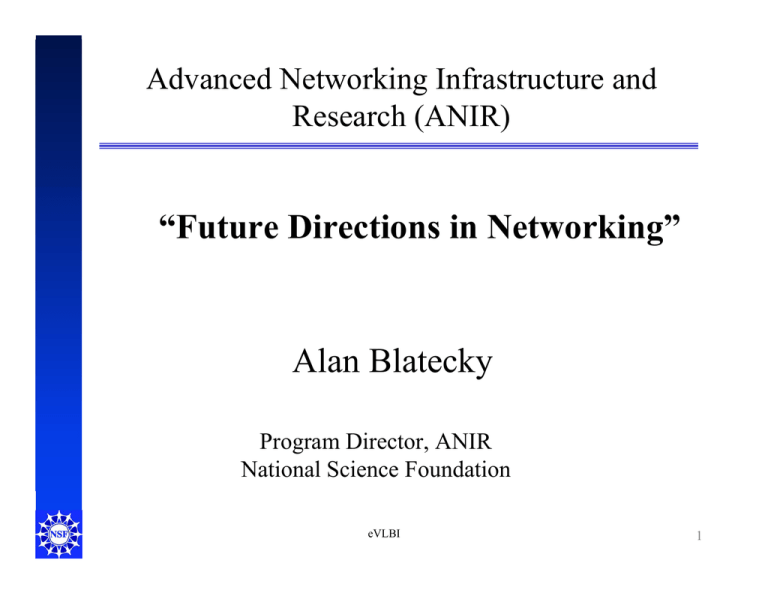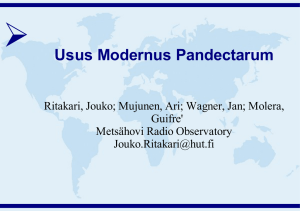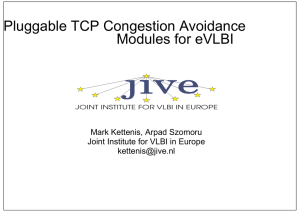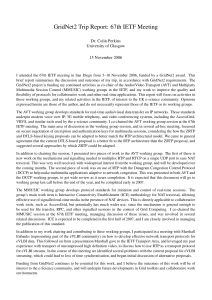Alan Blatecky “Future Directions in Networking” Advanced Networking Infrastructure and Research (ANIR)
advertisement

Advanced Networking Infrastructure and Research (ANIR) “Future Directions in Networking” Alan Blatecky Program Director, ANIR National Science Foundation eVLBI 1 Outline • • • • • • • • • Electrons to Photons: Network Speeds Electrons to Photons: Network Components Three Network Model Cyberinfrastructure Abilene Research Network Experimental Networks Experimental Network Characteristics Research Network International Participation eVLBI 2 Electrons to Photons: Network Speeds Photons Electrons Research Production and or in development Desktop connections Phone Modems DSL T1 Cable Modems Ethernet 1 Kbs 10 Kbs Research Production and or in development 100 Kbs 1 Mbs Future Desktop Network capacity ??? Future Network T3 OC3 OC48 OC768 Fast Ethernet GigE 10Gig DWDM 10 Mbs 100 Mbs 1 Gbs Bandwidth eVLBI 10 Gbs 100 Gbs ??? ??? 1 Tbs 10 Tbs 100 Tbs 1 Pbs 3 Electrons to Photons: Network components Electrical Circuit switches Packet switches IP Routers ATM, Ethernet, etc Electrical to Optical conversion SONET Packet over SONET DTM Today’s Technologies Optical Lambda switching Optical packet switching Optical burst switching MEMS, Holography, etc Tomorrow’s Technologies eVLBI 4 Three Network Model Abilene Circuit switches Packet switches IP Routers ATM, Ethernet, etc Electrical NSF Experimental Network SONET Packet over SONET DTM Electrical to Optical Conversion eVLBI NSF Research Network Lambda switching Optical packet switching Optical burst switching MEMS, Holography, etc Optical 5 Cyberinfrastructure • Recognition of the new requirement of infrastructure to support leading edge science and research • Dependence on technology for future scientific advances • Cyberinfastructure capabilities include – – – – – – computational power and high speed networks distributed, ad hoc and embedded sensor networks and arrays large data repositories systemic security large-scale interoperability and collaborative tools middleware eVLBI 6 Abilene Research Network * • Production Research Network – – – – 24x7 support High speed capacity 53 direct connections 207 participants • Extended service until October 2006 • Expanded capacity upgrades in process – moving to OC 192 • International connections through STARTAP and MOUs * Steve Corbato, Joint Techs Meeting, January 2002 eVLBI 7 Experimental Networks • Experimental networks are required to solve many e-Science problems • Experiments will be driven by Grand Challenge Applications – vantage point is the end-user – application performance is the success indicator • International connections required for multi-national e-science projects and programs • Collaboration across disciplines a hallmark • Systemic approaches to solve networking issues eVLBI 8 Experimental Network Characteristics • Quality of Service • Dedicated Provisioning for guaranteed data rates • Support of other network layers such as GMPLS and OBGP • Repeatable network experiments • Reconfigurability • Experimental protocols and approaches for high throughput, low latency, large bursts • End-to-End performance and support NSF CISE Grand Challenges in e-Science Workshop http://www.evl.uic.edu/activity/NSF/index.html eVLBI 9 Research Network Characteristics • • • • • • • Disruptive technologies and approaches Hybrid and experimental designs End-device research Core technology development New protocol research Alternative network architectures Testbed implementations eVLBI 10 International Participation • Coordination of advanced networking research activities and programs, including research production networks • Support of Grand Challenge applications which transcend geographic and national boundaries • Direct connections to the NSF Experimental Networks – multiple projects and connections – some problems can only be resolved by international partnerships • Joint strategic planning efforts for longer term support of e-Science and research eVLBI 11 eVLBI 12 MAGIC (Middleware And Grid Infrastructure Coordination) • Coordinates Interagency Grid and Middleware efforts – DOE, NASA, NIH, NSF, NIST, NOAA, DARPA • Enhances and encourages interoperable Grid and Middleware domains • Promotes usable, widely deployed middleware tools and services • Provides a Federal voice for effective international coordination of Grid and Middleware Technologies eVLBI 13 Magic Status • Established by LSN in February • Started meeting in next meeting May • Persistence and support of middleware identified as a critical immediate need • Heighten awareness of Open Source licensing among federal agencies • Conduct a workshop in early August; develop a “blue book” document eVLBI 14




